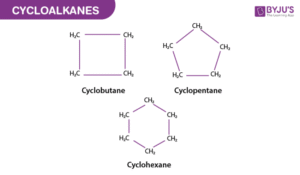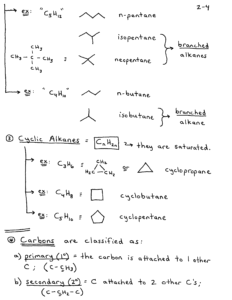Back to: Organic Chemistry 100 Level
Welcome to class!
Hey superstar! It’s so great to have you here again. I love how you keep showing up ready to learn—that’s exactly the spirit you need to succeed. Today, we’re going to talk about something very practical and common in our everyday lives: Alkanes and Cycloalkanes. Don’t worry, these big-sounding words are simpler than you think. Let’s break them down together in a way that makes perfect sense.
Alkanes And Cycloalkanes
What are Alkanes?
Alkanes are the simplest type of hydrocarbons—compounds made up of only carbon and hydrogen atoms. What makes them unique is that they contain only single bonds between the carbon atoms. They are saturated hydrocarbons, meaning each carbon atom is bonded to as many hydrogen atoms as possible.

Some common examples of alkanes are:
Methane (CH₄) – Found in cooking gas
Ethane (C₂H₆) – Also in LPG
Propane (C₃H₈) – Used in heating and cooking
Butane (C₄H₁₀) – Found in lighters
These alkanes are part of the fuels we use every day in Nigeria—from cooking to generating electricity.
Properties of Alkanes
They are usually non-polar and don’t dissolve in water.
They burn easily, releasing energy—this is why they are used as fuels.
They are mostly unreactive compared to other organic compounds, but they do undergo combustion and substitution reactions.
What are Cycloalkanes?
Cycloalkanes are just like alkanes, but their carbon atoms are arranged in a ring or circle instead of a straight line. The name tells you—”cyclo” means circle. So if an alkane forms a loop, it becomes a cycloalkane.

Examples include:
Cyclopropane (C₃H₆)
Cyclobutane (C₄H₈)
Cyclopentane (C₅H₁₀)
Cyclohexane (C₆H₁₂)
These compounds are often found in the structure of medicines and some natural oils.
Naming Alkanes and Cycloalkanes
Alkanes follow the basic IUPAC naming system using prefixes (meth-, eth-, prop-, etc.) and the suffix “-ane”.
For example:
CH₄ → Methane
CH₃–CH₃ → Ethane
Cycloalkanes add the “cyclo” prefix:
Ring of 3 carbons → Cyclopropane
Ring of 4 carbons → Cyclobutane
Example You Can Relate To
Think of alkanes as a straight line of children holding hands. Each child is holding one person’s hand on either side—very straightforward. But cycloalkanes are like a group of friends forming a circle at break time. They’re all still connected, just in a round shape!

Also, when you light your gas cooker to boil rice, you’re using butane or propane—that’s alkanes in action, right there in your kitchen!
Summary
- Alkanes are saturated hydrocarbons with single bonds only.
- They are commonly used as fuels.
- Cycloalkanes are similar to alkanes but have ring structures.
- Both follow the IUPAC naming rules, with cycloalkanes using the “cyclo” prefix.
- These compounds are part of everyday things like cooking gas, fuels, and industrial products.
Evaluation
- What makes alkanes different from other hydrocarbons?
- Give two uses of alkanes in everyday life.
- What does “cyclo” mean in cycloalkanes?
- Name the alkane with five carbon atoms.
- How is cyclopentane different from pentane?
You’re doing wonderfully well! You just learned about two important families of compounds that power your stove, your generator, and even help make products we use daily. Isn’t it amazing how chemistry is all around you? Keep shining, and remember that with Afrilearn, learning is always fun, simple and made just for you. See you in the next class, champion!
